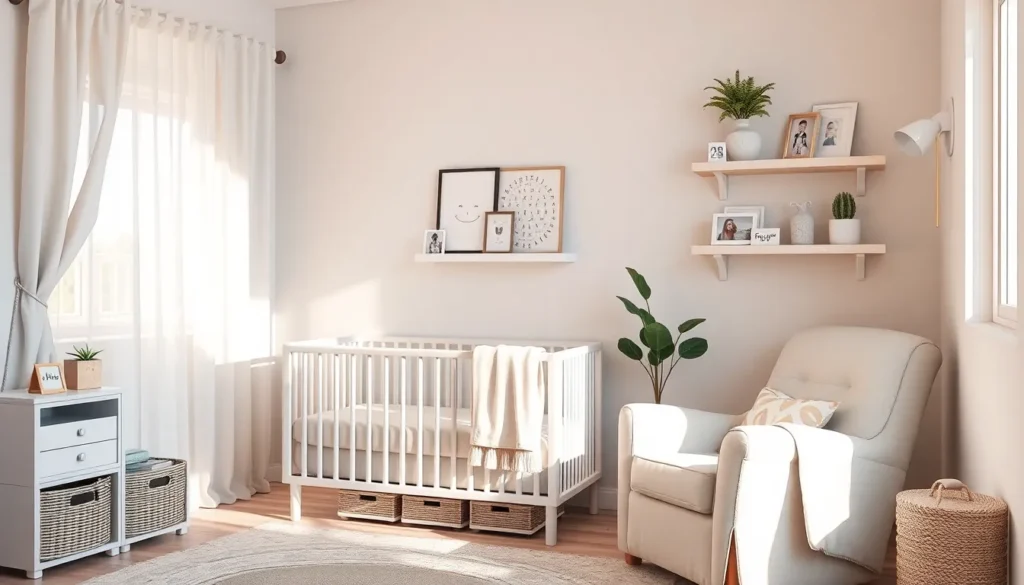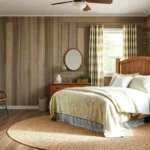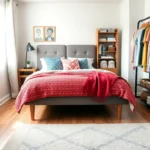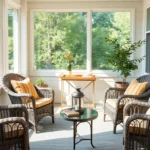Creating the perfect nursery isn’t just about picking pretty colors and cute decorations – it’s about designing a space where your little one will sleep safely and grow happily. We understand that expectant parents often feel overwhelmed by the endless options and conflicting advice about nursery design.
The good news? You don’t need a massive budget or interior design degree to create a beautiful and functional nursery. With the right planning and creative ideas we’ll share today you can transform any room into a cozy haven that reflects your style while meeting your baby’s needs.
Whether you’re working with a spacious room or a tiny corner we’ve gathered practical nursery ideas that combine safety functionality and style. From space-saving answers to timeless themes that grow with your child these concepts will help you create a nursery you’ll both love for years to come.
Choose a Calming Color Palette for Your Nursery
Colors profoundly impact your baby’s mood and sleep patterns, making palette selection one of the most crucial nursery decisions you’ll make.
Soft Pastels for a Soothing Atmosphere
Pastels create the serene environment every parent wants for their little one. Gentle blues promote restful sleep and reduce stress hormones in both babies and adults. Soft pinks encourage feelings of warmth and security while maintaining a peaceful ambiance. Lavender tones offer calming properties that can help fussy babies settle more easily.
Mint greens provide a fresh, organic feel that pairs beautifully with natural wood furniture. Pale yellows bring sunshine into the room without overwhelming your baby’s developing vision. Peach shades create a cozy, nurturing atmosphere that works well in rooms with limited natural light.
We recommend limiting pastel palettes to two or three colors maximum to avoid visual chaos. Cream or white trim helps define spaces and creates clean lines throughout the room.
Neutral Tones for Gender-Neutral Spaces
Neutral colors offer timeless elegance and practical versatility for growing families. Warm grays create sophisticated backdrops that complement any accent color you choose later. Beige tones provide earthiness while reflecting light to make small nurseries feel more spacious.
Soft whites brighten dark corners and create the perfect canvas for colorful artwork or toys. Taupe shades add depth without overwhelming delicate baby eyes. Sage greens bridge the gap between neutral and color while maintaining tranquil vibes.
Cream colors work exceptionally well with both warm and cool accent pieces. We’ve found that neutral nurseries photograph beautifully and appeal to visitors regardless of their color preferences.
Bold Accent Colors for Visual Interest
Accent colors stimulate your baby’s developing vision without creating overstimulation. Deep navy blues add sophistication when used on a single accent wall or in furniture pieces. Rich emerald greens create focal points that grow with your child’s changing tastes.
Terracotta oranges bring warmth and energy to otherwise neutral spaces. Dusty roses offer gentle contrast without the intensity of bright pinks. Charcoal grays provide modern elegance and hide inevitable stains better than lighter shades.
We suggest introducing bold colors through removable elements like curtains, rugs, or wall decals. This approach allows easy updates as your child develops preferences. Limit bold colors to 20% of your overall palette to maintain the calming atmosphere essential for quality sleep.
Create a Functional Layout That Grows With Your Baby

Building a functional nursery layout means thinking beyond the first few months to create a space that adapts as your child develops. We’ll show you how to create distinct zones for sleep, play, and storage that optimize both functionality and safety.
Position the Crib for Safety and Convenience
Placing your crib correctly forms the foundation of nursery safety and daily convenience. We recommend positioning the crib away from windows, cords, and other potential hazards to prevent entanglement or accidents that could harm your baby.
Central placement offers the best accessibility for parents during nighttime feedings and diaper changes. Consider locating the crib near the door but not directly in the pathway to maintain easy access while avoiding traffic flow disruption.
Windows present multiple risks including cord strangulation, temperature fluctuations, and direct sunlight exposure. Keep at least three feet of clearance between the crib and any window treatments or blinds to ensure your baby’s safety throughout their sleep.
Designate a Comfortable Nursing Corner
Creating a dedicated nursing area enhances your feeding experience and promotes bonding with your baby. We suggest selecting a comfortable chair with proper back support and armrests to reduce strain during extended feeding sessions.
Lighting plays a crucial role in establishing the right atmosphere for nursing sessions. Install a soft reading lamp or dimmer switch that provides adequate visibility without being too bright for nighttime feedings.
Add a side table within arm’s reach to store essential supplies like burp cloths, water bottles, and nursing pads. This setup ensures everything you need remains accessible without disturbing your baby during feeding time.
Position this corner away from high traffic areas to create a peaceful environment that supports both comfort and privacy for nursing mothers.
Plan Storage Answers for Easy Access
Smart storage planning keeps your nursery organized while ensuring essential items remain within easy reach during daily routines. We recommend installing shelves and drawers at appropriate heights that accommodate your current needs and future growth.
Open shelving works perfectly for frequently used items like diapers, wipes, and daily clothing changes. Place these storage answers near the changing area to streamline diaper changes and outfit switches throughout the day.
Secure storage becomes essential for hazardous materials or items that could pose choking hazards as your baby grows. Install childproof locks on lower cabinets and keep small objects, medications, and cleaning supplies in locked compartments.
Consider adjustable storage systems that can be reconfigured as your child transitions from baby to toddler stages. Modular cubes and adjustable shelving units offer flexibility that grows with your child’s changing needs and toy collections.
Select Essential Furniture Pieces for Maximum Utility

Smart furniture choices form the foundation of a well-designed nursery that grows with your child. We’ll explore three fundamental pieces that maximize utility while ensuring safety and comfort.
Invest in a Convertible Crib
Convertible cribs represent one of the most practical investments you’ll make for your nursery. These versatile pieces transform from a standard crib into a toddler bed and eventually into a full-sized bed as your child grows. This adaptability extends the furniture’s lifespan significantly while providing a safe sleeping environment throughout different developmental stages.
We recommend selecting convertible cribs with sturdy construction and non-toxic finishes to ensure durability. Most models feature adjustable mattress heights that accommodate your baby’s growth and mobility changes. The conversion process typically requires additional hardware that many manufacturers include with the original purchase.
Choose a Changing Table With Built-in Storage
Changing tables with integrated storage streamline diaper changes while keeping essentials within arm’s reach. These functional pieces eliminate the need for separate storage units and create an organized changing station. Built-in compartments accommodate diapers, wipes, creams, and spare clothes without cluttering your nursery space.
Safety features make these changing tables indispensable for frequent diaper changes. Many models include safety straps to secure your baby during changes and raised edges to prevent rolling. We suggest selecting tables with multiple storage levels to separate clean supplies from soiled items effectively.
Add a Comfortable Glider or Rocking Chair
Gliders and rocking chairs create essential comfort zones for feeding sessions and soothing your baby. These chairs support long nursing or bottle-feeding periods while providing gentle motion that calms fussy infants. The rocking motion helps establish a peaceful atmosphere that benefits both parent and child during those late-night moments.
Comfort becomes paramount when selecting seating since you’ll spend considerable time in this chair. We recommend testing chairs for proper back support and armrest height before purchasing. Many parents find gliders with Ottoman sets particularly beneficial for maintaining comfortable positioning during extended feeding sessions.
Incorporate Creative Wall Decor and Art

Transforming your nursery walls into captivating focal points doesn’t require professional design skills. We’ll show you how to create stunning visual displays that grow with your child while maintaining the calming atmosphere essential for quality sleep.
Design a Gallery Wall With Personal Photos
Gallery walls create a visually appealing narrative that makes your nursery uniquely personal and meaningful. We recommend mixing frame styles and sizes to achieve a ever-changing look that captures attention without overwhelming the space. Personal photos, artwork, and sentimental pieces work together to tell your family’s story on the wall.
Start with your largest piece as the anchor point, then build around it with smaller frames in complementary colors. We suggest using a cohesive color palette that matches your nursery’s overall scheme, ensuring the gallery wall enhances rather than competes with your carefully chosen decor. Measure and mark your wall layout on paper first to avoid unnecessary holes and achieve perfect spacing.
Include meaningful artwork alongside family photos to create depth and visual interest. Baby’s first ultrasound images, handwritten quotes, or custom illustrations add personal touches that make the space truly special. We recommend leaving room for future additions as your child grows and creates their own artwork.
Install Floating Shelves for Display and Storage
Floating shelves serve dual purposes by providing both display opportunities and practical storage answers in your nursery. We love how they hold books, toys, and framed photos while maintaining the clean lines essential for a calming environment. These versatile additions maximize vertical space without overwhelming smaller nurseries.
Position shelves at varying heights to create visual interest and accommodate different storage needs throughout your child’s development. We suggest installing them at least 36 inches above the crib for safety, ensuring they’re securely anchored to wall studs to support the weight of books and decorative items. Lower shelves become accessible to toddlers as they grow, encouraging independence and organization.
Choose shelves that complement your nursery’s style whether you prefer sleek modern lines or rustic wood finishes. We recommend birch branch shelves for woodland themes or clean white floating shelves for minimalist designs. Consider adding small bins or baskets to contain smaller items and maintain the organized appearance that supports peaceful sleep.
Use Removable Wall Decals for Easy Updates
Removable wall decals offer the perfect solution for parents who want to update their nursery’s theme without damaging walls or committing to permanent changes. We appreciate how these versatile decorations can transform a room instantly and adapt as your child’s interests evolve from infancy through toddlerhood.
Select high quality vinyl decals that remove cleanly without leaving residue or damaging paint underneath. We recommend testing a small area first to ensure compatibility with your wall finish. 3D printed decorations like butterflies add whimsical touches that stimulate your baby’s developing senses while creating captivating visual elements.
Plan your decal placement carefully to create balanced compositions that enhance your nursery’s overall design. We suggest avoiding areas directly above the crib where pieces might fall, instead focusing on accent walls or spaces around changing areas. Custom wooden name signs can anchor your decal design while adding a personalized touch that makes the nursery uniquely yours.
Transform entire walls with mural style decals that transport your baby into magical worlds like enchanted forests or celestial night skies. We love how these larger designs create immersive environments that spark imagination while maintaining the gentle atmosphere necessary for restful sleep.
Design Clever Storage Solutions to Minimize Clutter
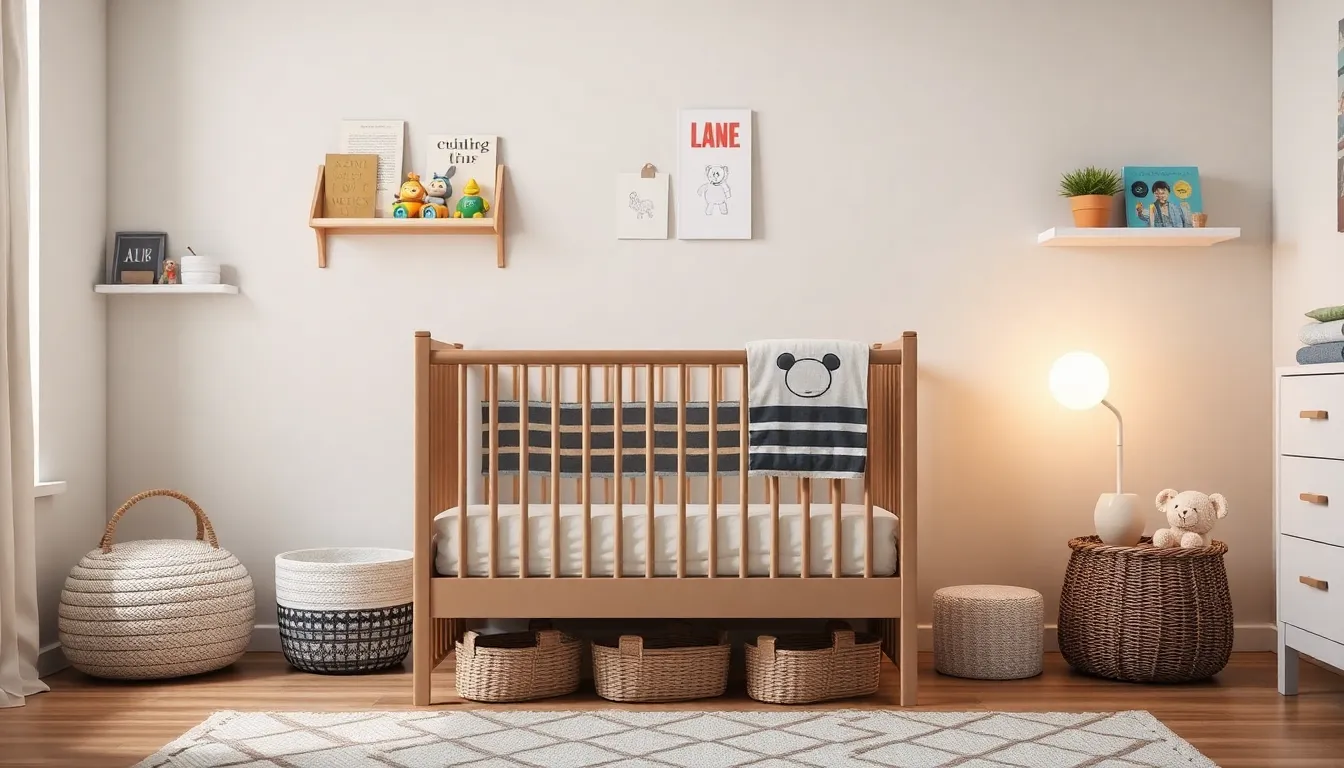
Smart storage transforms your nursery from chaotic to organized while maintaining the beautiful aesthetic you’ve carefully created. We’ll show you how strategic storage answers maximize every inch of space while keeping essentials within easy reach.
Use Under-Crib Storage Baskets
Maximize that valuable under crib real estate by sliding in attractive storage baskets or bins that blend seamlessly with your nursery design. We recommend choosing baskets with handles for easy access when you need to grab extra bedding during those inevitable middle of the night sheet changes.
Store seasonal items like outgrown clothes or future size clothing in these convenient spaces while keeping current essentials accessible. Rolling bins work exceptionally well since they glide out smoothly without requiring you to crawl under the crib.
Keep extra linens organized by dedicating one basket to sheets and blankets while using another for toys that aren’t part of the daily rotation. This approach prevents your floor from becoming cluttered while making use of otherwise wasted vertical space.
Install Wall-Mounted Organizers
Wall mounted shelves create additional storage without taking up valuable floor space that’s already at a premium in most nurseries. We suggest installing floating shelves at varying heights to store books, decorative items, and frequently used supplies like lotions or burp cloths.
Hook systems mounted on walls provide instant organization for items you need to grab quickly during diaper changes or feeding sessions. These simple additions keep jackets, blankets, or even tomorrow’s outfit easily accessible without requiring drawer space.
Open shelving systems allow you to see everything at a peek while encouraging you to maintain organization since items remain visible. We find that parents are more likely to keep things tidy when storage answers don’t hide the mess.
Create a Toy Storage System That’s Easy to Maintain
Labeled bins and baskets make cleanup time manageable for both you and your growing child while teaching early organizational skills. We recommend using picture labels alongside words so toddlers can independently identify where toys belong.
Multi use storage baskets serve double duty by storing shoes, toys, books, or essential items like diaper pads and wipes in one attractive container. Choose baskets that complement your nursery’s color scheme while providing the durability needed for daily use.
Armoires offer substantial storage for clothes and accessories when closet space is limited or nonexistent in your nursery. These pieces keep everything organized and out of sight while providing a substantial storage solution that grows with your child’s needs.
Add Soft Lighting Options for Day and Night
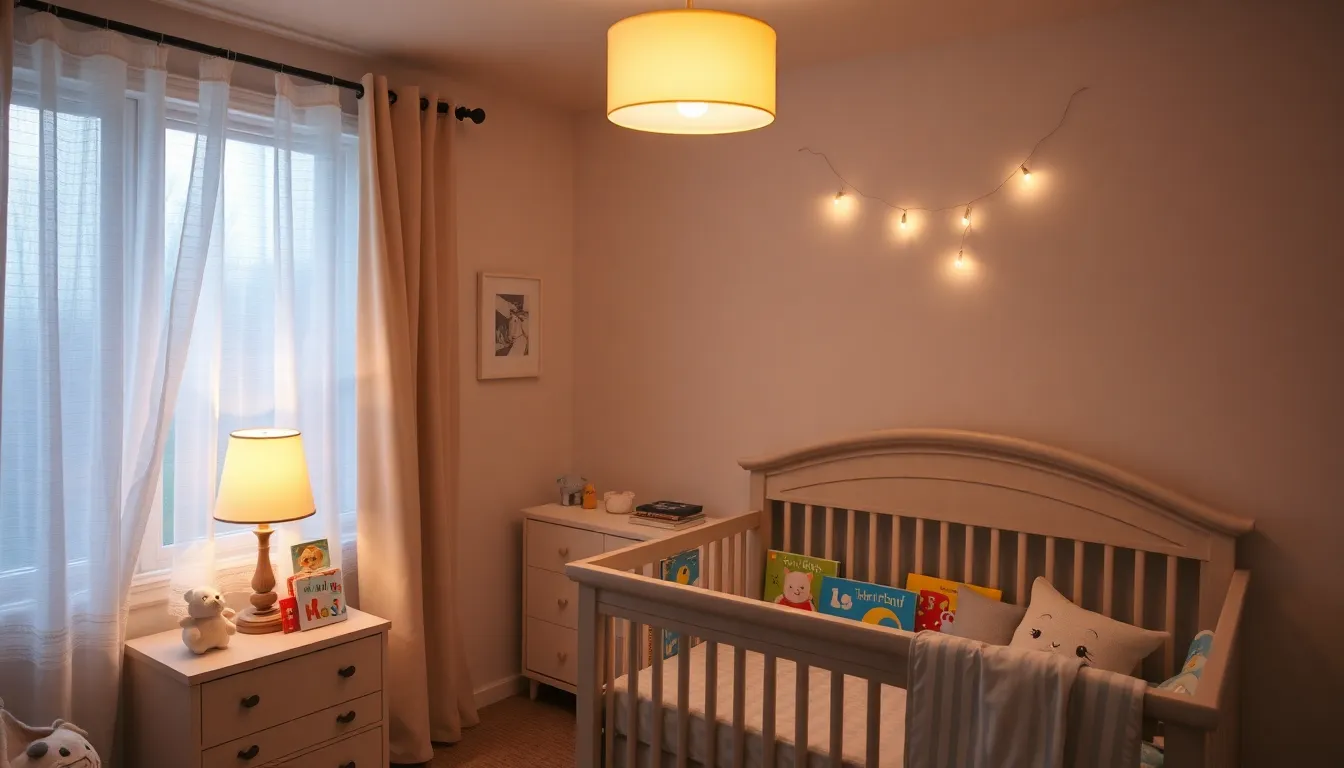
Creating the perfect lighting atmosphere transforms your nursery into a cozy sanctuary that adapts to your baby’s daily needs. We’ll explore versatile lighting answers that provide both functionality and warmth throughout the day and night.
Install Dimmer Switches for Flexible Lighting
Dimmer switches offer unmatched versatility for adjusting brightness levels throughout your nursery. We recommend installing these controls on overhead lighting to create bright environments for daytime activities like playing and reading. Gentle illumination becomes possible during nighttime routines without startling your little one awake.
Table lamps and shelf lamps work beautifully with dimmer controls to provide localized warm light. These fixtures create perfect reading nooks while offering adjustable brightness for different activities. Pendant lights with woven or lattice effects add whimsical charm when paired with dimming capabilities.
Flexibility becomes essential as your child grows and their lighting needs change. We’ve found that dimmer switches eliminate the need for multiple light sources while maintaining optimal comfort levels. Evening routines benefit significantly from gradually reduced lighting that signals bedtime naturally.
Choose Night Lights for Safe Navigation
Night lights provide crucial safety benefits for nighttime navigation without disrupting your baby’s sleep patterns. We suggest placing these gentle illumination sources along pathways between the door and crib area. Strategic positioning near changing stations ensures you can tend to your baby safely during those inevitable middle-of-the-night visits.
Modern night lights offer various intensity levels and color options to minimize sleep disruption. Warm amber or red tones preserve natural melatonin production better than bright white lights. We recommend choosing models with automatic sensors that activate only when needed.
Portable night lights provide additional flexibility for travel or room transitions. Battery-powered options eliminate cord hazards while maintaining consistent lighting wherever your child sleeps. LED technology ensures these safety lights remain cool to the touch and energy efficient.
Incorporate Natural Light With Appropriate Window Treatments
Natural light plays a vital role in establishing healthy sleep-wake cycles for your growing baby. We recommend maximizing daylight exposure during morning and afternoon hours to support natural circadian rhythm development. Strategic window placement helps create bright, cheerful spaces for daytime activities and play.
Appropriate window treatments become essential for controlling harsh sunlight and maintaining comfortable room temperatures. Curtains or blinds allow precise light management throughout the day while providing complete darkness for naptime. Blackout options work particularly well for babies who need consistent sleep environments.
Layered window treatments offer maximum flexibility for different lighting needs. We suggest combining sheer panels for gentle light filtering with heavier curtains for complete light blocking. Cordless options eliminate safety hazards while maintaining easy operation for busy parents.
Accent lighting using LED strips or fairy lights creates magical atmospheres during evening routines. These decorative elements add soothing touches without overwhelming your nursery’s overall design. Safety considerations remain paramount with all lighting choices, ensuring fixtures remain child-friendly with no exposed wires or choking hazards.
Choose Safe and Comfortable Flooring Materials

Selecting the right flooring materials creates the foundation for your nursery’s safety and comfort. We’ll explore options that provide cushioning for falls while maintaining easy maintenance for busy parents.
Consider Soft Area Rugs for Playtime
Soft area rugs transform hard flooring surfaces into comfortable play zones for your little one. We recommend placing these versatile pieces over hardwood or laminate floors to create designated areas where children can crawl, roll, and explore safely.
Removable rugs offer practical advantages for busy parents since they can be easily cleaned or replaced when accidents happen. Choose washable options that can handle frequent laundering without losing their softness or color vibrancy.
Strategic placement of area rugs helps define different zones within the nursery such as feeding areas, play spaces, and reading corners. We suggest selecting rugs with non-slip backing to prevent sliding during active play sessions.
Select Easy-to-Clean Flooring Options
Luxury Vinyl Tiles (LVT) provide water-resistant and stain-resistant surfaces that handle nursery spills and accidents with minimal fuss. These durable materials resist moisture while offering comfort underfoot for extended play sessions.
Ceramic or porcelain tiles deliver exceptional durability and waterproof protection for high-traffic nursery areas. But, we recommend pairing these harder surfaces with area rugs to provide additional comfort during floor play.
Laminate flooring offers budget-friendly answers that resist scratches and moisture damage from daily nursery activities. This option works particularly well for parents seeking low-maintenance surfaces that can withstand years of use.
Stain-resistant carpet provides warmth and natural cushioning that’s ideal for nursery environments. We suggest choosing varieties specifically designed for easy cleaning to maintain hygiene standards in your baby’s space.
Add Foam Floor Tiles for Extra Cushioning
Foam floor tiles create soft surfaces that reduce impact from inevitable tumbles during your child’s developmental stages. We recommend installing these interlocking pieces in dedicated play areas where crawling and walking practice occurs most frequently.
Removable foam tiles allow for easy cleaning and replacement when individual sections become worn or damaged. Choose tiles that interlock securely to prevent gaps where small fingers or toys might get caught.
Colorful foam options can enhance your nursery’s design while providing practical safety benefits for active toddlers. We suggest selecting tiles that match your existing color palette to maintain visual harmony throughout the space.
Cork flooring delivers eco-friendly cushioning properties that naturally absorb impact while providing antimicrobial benefits. This sustainable option offers excellent thermal insulation and sound dampening for multi-story homes.
Create a Themed Nursery That Reflects Your Style
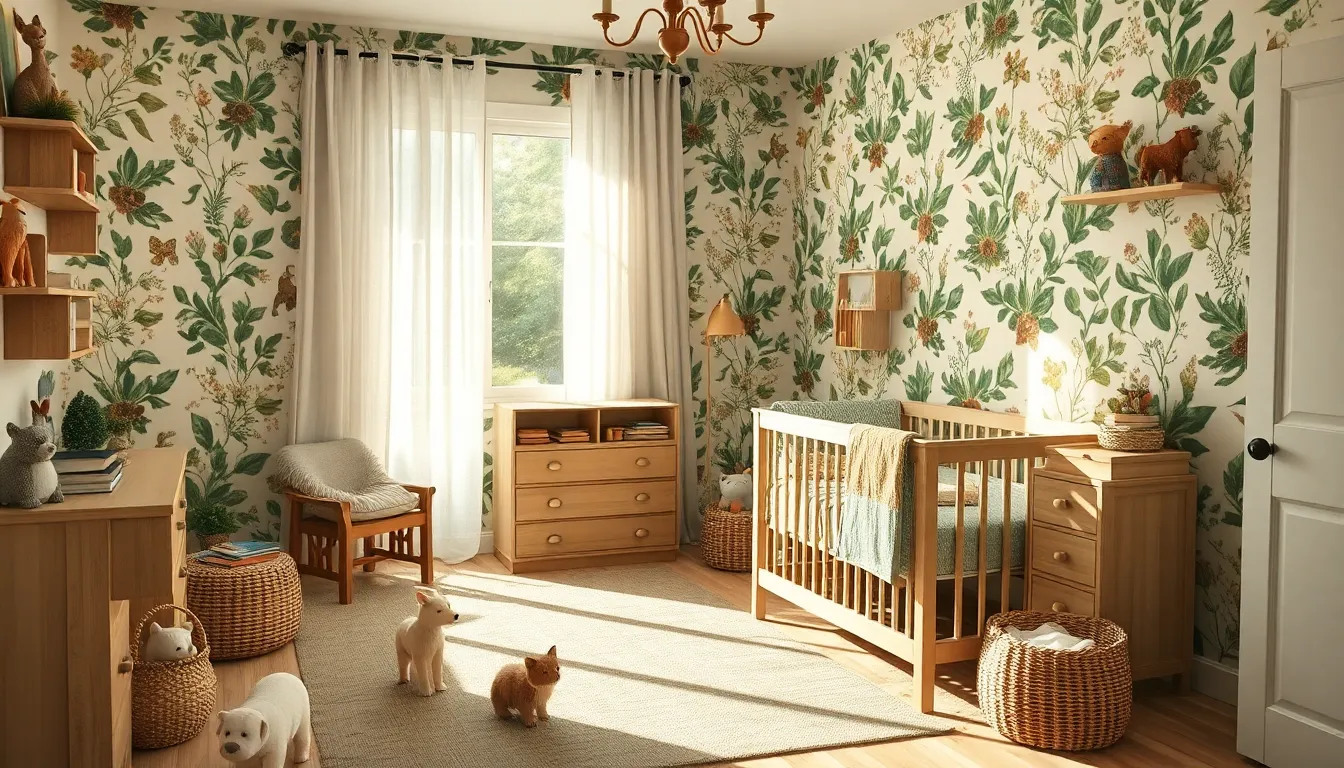
Choosing a exact theme transforms your nursery from a simple room into a personalized sanctuary that reflects your family’s interests and values. We’ll explore three popular approaches that create stunning, cohesive spaces for your little one.
Nature-Inspired Themes for Outdoor Lovers
Nature themed nurseries bring the tranquility of the outdoors inside while creating a peaceful environment for sleep and play. Botanical wallpapers featuring wildflowers, trees, and woodland scenes serve as stunning focal points that capture the beauty of natural landscapes. We recommend incorporating earthy color palettes with greens, browns, and muted blues to establish a calming foundation that promotes restful sleep.
Woodland animals like deer, foxes, and birds add playful charm through wall art, soft toys, and decorative accents. Natural textures become essential elements when we use materials like wood, rattan, and wool throughout the space. Mountain and forest murals create immersive backdrops that spark imagination and wonder. Butterfly motifs and floral touches provide gentler alternatives for parents seeking softer nature connections.
Storage answers can incorporate woven baskets and wooden organizers that maintain the organic aesthetic while providing functionality. We suggest adding plants or botanical prints to windowsills and shelving areas to reinforce the outdoor connection safely.
Storybook Themes for Literary Families
Storybook nurseries celebrate beloved children’s literature while encouraging early literacy development from birth. Classic fairy tales, Dr. Seuss illustrations, and Disney characters provide endless inspiration for wall art, bedding, and decorative elements. Bold or pastel color schemes work depending on your chosen story’s mood and visual style.
Reading nooks become natural additions to these themed spaces, complete with comfortable seating and built in bookshelves shaped like castles or storybook pages. We recommend using wall decals featuring iconic book quotes or character silhouettes for easy updates as your child’s interests evolve. Oversized paper lanterns and themed props create three dimensional storytelling elements that engage visual development.
Display areas for favorite books encourage interaction with literature from an early age. Consider incorporating storybook inspired lighting fixtures or lampshades that cast magical shadows during bedtime routines. Props like treasure chests for toy storage or character themed growth charts blend functionality with whimsical design elements.
Modern Minimalist Themes for Clean Aesthetics
Modern minimalist nurseries emphasize simplicity and functionality through carefully curated design choices. Neutral color schemes using white, black, gray, or soft pastels create serene environments that promote calm and focus. Sleek furniture with clean lines maximizes space efficiency while maintaining visual appeal.
Storage answers remain hidden or multifunctional to preserve the uncluttered aesthetic that defines minimalist design. We choose quality over quantity when selecting decor items, focusing on pieces that serve multiple purposes. Geometric shapes and monochrome prints provide visual interest without overwhelming the peaceful atmosphere.
Durable, easy to clean fabrics and flooring materials support the practical aspects of minimalist living with babies. Simple accent pieces like sculptural mobiles or single statement artworks create focal points without cluttering the space. Natural light becomes a key design element, enhanced by streamlined window treatments that maximize brightness while providing necessary room darkening options.
Incorporate Personal Touches and Family Heirlooms
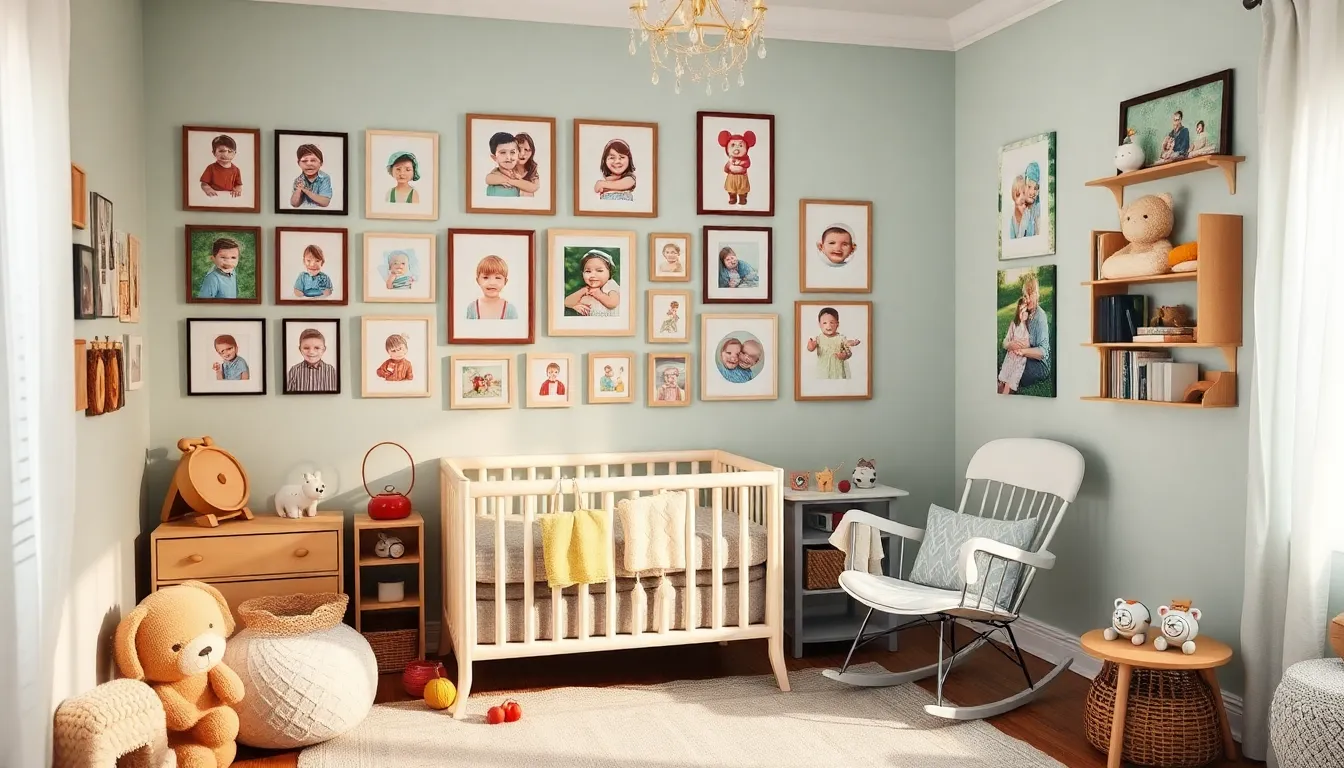
Creating a nursery that reflects your family’s unique story transforms the space from a simple baby’s room into a meaningful sanctuary. Personal touches connect your child to their heritage while building emotional bonds that’ll last a lifetime.
Display Meaningful Artwork and Photos
Personalized wall art featuring custom prints with meaningful quotes or birth announcements creates a special connection between the space and your baby. We recommend selecting pieces that reflect your family’s values and aspirations for your little one.
Framed photos of family members add warmth and create visual stories throughout the room. Position these at your child’s eye level as they grow so they can easily recognize beloved faces and feel surrounded by love.
Artwork that reflects your family’s style or cultural background serves as both decoration and education. Choose pieces that’ll spark conversations as your child develops, creating opportunities to share family history and traditions.
Gallery walls combining family photos with meaningful artwork create a unique narrative while maintaining the calming atmosphere essential for sleep. Mix different frame sizes and styles to add visual interest without overwhelming the space.
Include Handmade Items and DIY Projects
Handmade wooden toys or other crafts add personal touches that can’t be purchased in stores. These items often become cherished keepsakes that carry special meaning throughout your child’s life.
DIY projects such as wall decals, mobiles, or decorative items help you save money while adding personal flair to the nursery. Creating these pieces yourself allows you to customize colors, patterns, and themes to perfectly match your vision.
Custom name art or monogrammed items personalize the space and make it feel special and loved. We suggest incorporating your child’s name into various elements like wall letters, embroidered pillows, or painted canvas art.
Handcrafted storage answers like painted wooden bins or sewn fabric baskets combine functionality with personal style. These practical DIY projects help maintain organization while showcasing your creativity and attention to detail.
Integrate Family Traditions and Cultural Elements
Cultural symbols or patterns incorporated into the nursery design reflect your heritage and introduce your child to their roots from day one. Consider using traditional textiles, color schemes, or decorative motifs that hold special significance for your family.
Family traditions represented through meaningful objects create a sense of continuity between generations. Display items like traditional clothing, ceremonial pieces, or handcrafted heirlooms that tell your family’s story.
Vintage pieces and family heirlooms give the nursery a unique character that mass-produced items simply can’t provide. A restored rocking chair from grandma or a repurposed family chest creates instant history in your child’s space.
Religious or spiritual elements can be thoughtfully integrated to reflect your family’s beliefs and values. Choose items that provide comfort and guidance while remaining appropriate for a child’s environment.
Plan for Future Transitions as Your Child Grows

Smart nursery design anticipates your child’s evolving needs from infancy through adolescence. We’ll explore strategies that ensure your carefully planned space remains functional and relevant as your little one grows.
Choose Adaptable Furniture and Decor
Convertible cribs serve as the foundation of adaptable nursery design, transforming from cribs to toddler beds and eventually full-sized beds. These multi-stage pieces extend functionality for years while maintaining safety standards throughout each transition.
Dressers that double as changing tables maximize space efficiency while providing long-term storage answers. We recommend selecting pieces with removable changing toppers that reveal standard dresser surfaces once diaper changes become unnecessary.
Minimalist decor approaches ensure easy modifications as your child’s preferences evolve. Simple color schemes and uncluttered surfaces allow for quick updates without complete room overhauls.
Neutral furniture finishes like white, gray, or natural wood tones adapt to changing color preferences and design themes. These versatile foundations support various decorative elements without clashing or becoming outdated.
Design Flexible Storage Answers
Modular shelving units offer unparalleled adaptability for growing storage needs. These systems expand vertically or horizontally while accommodating everything from baby bottles to school supplies as your child develops.
Adjustable closet organizers maximize wardrobe space efficiency across different clothing sizes and types. We suggest installing systems with moveable shelves and hanging rods that accommodate infant onesies through teenage wardrobes.
Multi-purpose storage ottomans provide seating, toy storage, and footrests in one compact piece. These versatile answers adapt from diaper storage to assignments supplies without requiring additional furniture purchases.
Built-in storage benches create organized spaces while offering comfortable seating for bedtime stories or shoe tying practice. Custom answers integrate seamlessly with room architecture and provide lasting functionality.
Consider Long-term Functionality
Eco-friendly materials ensure healthy environments while supporting sustainable design practices. We prioritize low-VOC paints, formaldehyde-free furniture, and natural fiber textiles that maintain air quality throughout your child’s development.
Multifunctional space planning transforms nurseries into versatile environments like nursery-office hybrids. These dual-purpose designs accommodate work-from-home parents while preparing for eventual conversion to study spaces or guest rooms.
Technology integration points future-proof nurseries for evolving digital needs. Installing adequate electrical outlets, cable management systems, and wireless network coverage supports everything from baby monitors to teenage gaming setups.
Room layout flexibility maintains open floor plans that accommodate changing furniture arrangements. We recommend avoiding built-in elements that limit reconfiguration options as your child’s activities and space requirements evolve.
Conclusion
Creating your dream nursery doesn’t have to be overwhelming or expensive. With thoughtful planning and the right approach you can design a space that’s both beautiful and functional for years to come.
Remember that the best nurseries grow with your child. By choosing adaptable furniture smart storage answers and flexible design elements you’re investing in a room that’ll serve your family well beyond the baby years.
We believe every parent deserves a nursery that reflects their love and values while providing safety and comfort. Trust your instincts embrace your personal style and don’t forget to enjoy this special time of preparation. Your little one’s perfect sanctuary awaits!
Frequently Asked Questions
What is the most important factor to consider when designing a nursery?
Safety should be your top priority when designing a nursery. This includes positioning the crib away from windows and hazards, securing furniture to walls, choosing non-toxic materials, and ensuring proper ventilation. While aesthetics matter, a safe environment where your baby can sleep and play securely is essential for their well-being and your peace of mind.
What colors work best for a baby’s nursery?
Soft pastels and neutral tones are ideal for nurseries as they create a calming atmosphere that promotes better sleep. Colors like soft blues, gentle greens, and warm grays work well. Limit bold accent colors to about 20% of your overall palette to add visual interest without overwhelming the space or overstimulating your baby.
How can I create a functional nursery layout?
Focus on three key zones: sleeping area with the crib safely positioned, a comfortable nursing corner with proper seating and lighting, and organized storage solutions. Ensure clear pathways between areas and keep frequently used items within easy reach. Plan for adaptability as your child grows from baby to toddler stages.
What essential furniture pieces should I invest in for a nursery?
A convertible crib that transforms from crib to toddler bed, a changing table with built-in storage, and a comfortable glider or rocking chair are the must-have pieces. These items provide long-term value and functionality. Choose furniture with safety certifications and consider pieces that can adapt as your child grows.
How can I maximize storage in a small nursery?
Use vertical space with floating shelves and wall-mounted organizers. Under-crib storage baskets, labeled bins, and modular shelving systems help maintain organization. Consider a dresser that doubles as a changing table and use closet organizers to maximize space. Keep frequently used items accessible while storing seasonal items higher up.
What lighting options work best for a nursery?
Install dimmer switches for flexible overhead lighting, use table lamps with warm light for nursing areas, and add night lights for safe nighttime navigation. Maximize natural light with layered window treatments that include blackout options for naps. Avoid harsh fluorescent lighting and ensure all fixtures are safely out of reach.
Can I design a beautiful nursery on a budget?
Absolutely! Focus on DIY projects, repurpose existing furniture with fresh paint, and shop secondhand for quality pieces. Use removable wall decals instead of expensive wallpaper, create your own artwork, and invest in a few key pieces while saving on accessories. Personal touches often matter more than expensive items.
How do I choose the right flooring for a nursery?
Select soft, easy-to-clean options like luxury vinyl tiles, laminate flooring, or stain-resistant carpets. Add washable area rugs for comfort and warmth. Consider foam floor tiles for play areas to provide extra cushioning. Avoid hard surfaces like hardwood in play zones and ensure all materials are non-toxic and baby-safe.
What are some popular nursery themes to consider?
Nature-inspired themes with botanical elements and earthy colors create tranquil environments. Storybook themes celebrate literature with cozy reading nooks. Modern minimalist designs focus on clean lines and neutral palettes. Choose themes that reflect your family’s style while ensuring they can adapt as your child develops preferences.
How can I incorporate personal touches into the nursery?
Display family photos, meaningful artwork, and heirlooms that reflect your heritage. Create DIY projects like handmade mobiles or painted artwork. Include cultural elements and family traditions in the decor. Personalized wall art with your baby’s name or birth details adds special meaning while creating a unique family sanctuary.

